Last Updated on January 25, 2024 by Greg Gillson
Northern Cardinals are medium-sized songbirds found in the eastern and southwestern United States. They are found in deciduous woodlands, riparian corridors, and deserts. In all regions they seek dense tangles and vines.
Cardinals are especially fond of suburban yards. Both the bright red males and olive brown females have a crest and large conical red bills. These bills are perfect for eating larger seeds at backyard feeders such as sunflower and safflower seeds that cardinals really like. Keep reading to learn what else that Northern Cardinals like to eat and how to attract them.
This page is a supplement to my overview page on attracting Northern Cardinals. That page leads to other more in-depth pages answering questions like Where do cardinals live? Where do they nest? How do you identify them?
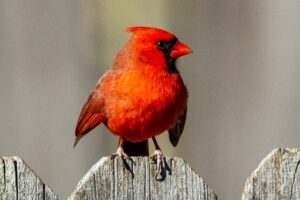
Diet and natural foods
Northern Cardinals eat insects in spring and summer. They eat a wide variety of insects. Beetles, spiders, termites, grasshoppers, caterpillars, cutworms, are just some of the arthropods that cardinals eat.
Northern Cardinals will eat many kinds of wild fruits and berries when they are ripe, summer through winter.
In winter, cardinals eat primarily seeds, including grass and weed seeds. They will eat tree nuts. They also eat waste grains such as rice, corn, and oats.
In spring, cardinals also eat flower blossoms and buds of elm trees and other plants.
Northern Cardinals at the backyard feeder
Foods to attract Northern Cardinals
The colorful Northern Cardinals are easy to attract to your bird feeders. They really like suburban backyards that contain broadleaf trees, scattered conifers, and denser bushes and vines.
Cardinals like sunflowers. Since they have a larger stronger bill, they aren’t as picky as some smaller sparrows and finches. They love black oil sunflower seeds, but also the larger eat striped sunflowers with their heavier shells.
Another seed that Northern Cardinals like are safflower seeds. Many birds that eat sunflower seeds will also eat safflower seeds. Given the choice, though, studies show that black oil sunflower seeds are preferred by all birds over safflower seeds. Nevertheless, cardinals find safflower seeds a close second. Thus, you can find “Cardinal Mix” bird seed that is a combination of sunflower and safflower seeds. Here’s one:
The cardinal mix above contains black oil sunflower and safflower seeds. It also contains white proso millet–a favorite of most backyard seed eating birds–and cracked corn. Cardinals like cracked corn, more so than many other backyard birds.
Some backyard bird feeding enthusiasts put out safflower seeds only in a separate feeder for cardinals. This is because squirrels generally don’t like safflower!
Of course, you can put out fruits and berries for cardinals, too. Apples slices are one fruit mentioned specifically that cardinals will eat.
Crushed peanuts are also mentioned by some as eaten by cardinals. Also suet, but small shreds rather than blocks. I’m not sure why this is so. Perhaps because many suet feeders are hard for cardinals to perch on? They do need a solid shelf on which to stand and feed.
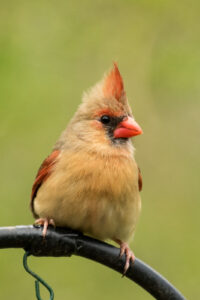
What is the best bird feeder for Northern Cardinals?
Northern Cardinals naturally like to feed on the ground. Thus they like platform feeders and hopper feeders with ample ledges or trays to stand on. [See my article on different types of bird feeders.]
A platform feeder with safflower seeds spread out will allow cardinals to feed and will not attract squirrels! These can be placed quite low to the ground. In fact, you may scatter some safflower on the ground if you know you will be having cardinals visit.
If you feed a seed mix, or primarily sunflowers, you’ll want to add squirrel baffles to your bird feeder pole or use a “squirrel-proof” feeder. That is, if you have squirrels in your yard.
Window bird feeders allow for close-up views of cardinals and other birds. Once you have birds feeding regularly in your yard they will more quickly find and approach a window feeder. Once they are accustomed to seeing you through the window, they will gradually become less wary and flighty.
Squirrel resistant bird feeders have an adjustable trigger that closes the feeding ports when heavy squirrels (or Starlings) land on the perch. The feeder is rather large, so doesn’t have to be refilled as frequently. It will need a sturdy mounting pole, though.
Fly-thru platform feeders have a screen bottom to help keep bird seed dry and rain will drain through. Cardinals will really like this feeder. so will sparrows, towhees, and other ground-feeding birds. Unfortunately, starlings, blackbirds, and jays may find this too easy to steal food from. So this might be a good feeder to stay with simply safflower, which other birds might not eat as readily.
Feeding and foraging behavior
Northern Cardinals normally feed on the ground. They hop along, searching for food. Sometimes they scratch at the ground or kick over leaves. They usually don’t venture far from cover.
They will feed on the ground as described above, under your feeder, looking for any spilled seeds. But they will also fly up to your feeder if it is a platform or has a wide enough tray on it to feed comfortably.
In the feeder they usually sit still and “chew” their food. They manipulate the seed in their bill and crack it open. Then they use their tongue to remove the seed. They swallow the seed kernel and let the inedible shells fall out of their mouths. Other smaller nuthatches and chickadees will grab a single seed and fly off to pound it open on a convenient tree branch. Not so the cardinal. The cardinal will just sit there in the feeder and eat one seed after another, as will sparrows and finches.
In the spring and summer you may only have singleton cardinals and pairs coming to your feeder. During this time the pair can be highly territorial and drive off other cardinals. After the breeding season the young-of-the-year may hang around the feeders for a while. But the parents may drive them off as they raise another brood immediately after.
In winter, though, Northern Cardinals can form large friendly flocks of up to 50 birds! Do you have enough seed for that?!!! Perhaps you won’t have that many birds at once, unless you live in the center of their range in the southern Midwest or northern Southeast.
Are you thinking that there are cardinals around but they just aren’t coming to your feeder? Try looking again at dawn and dusk. Northern Cardinals will often be the first birds at your feeder in the morning. They may be the last birds to feed at night. This may be happening before sunrise and after sunset, but not in full darkness. They may be coming to your feeder when you’re not expecting and not looking!
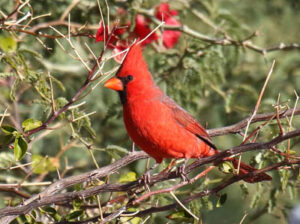
Water
Northern Cardinals love water! They both bathe and drink from bird baths. Dripping water, misters, or fountains really add to the appeal of bird baths for all birds, including cardinals.
Cardinals are larger than some other backyard feeder birds. So they will be at home in a larger and deeper bird bath. They may use the larger decorative baths that some of the smaller birds avoid.
Of course, being a ground feeder, cardinals would just as readily use a clay saucer on the ground.
Return to the overview page on attracting Northern Cardinals.
Wrapping Up
The Northern Cardinal, with its vibrant red plumage and captivating song, is a beloved icon of many North American landscapes. Here are some fascinating facts about this charismatic bird:
Appearance:
- Male Marvel: They are most recognized for their stunning appearance, with males boasting a fiery red body, black mask, and sharp white bill. Their crest adds a regal touch, making them truly eye-catching.
- Subtle Ladies: Females are less brightly colored, showcasing brown plumage with hints of red on the wings and chest. Despite their muted tones, they retain an elegant charm.
- Year-Round Residents: Unlike many songbirds, Cardinals are non-migratory, gracing our landscapes with their presence throughout the year.
Song and Voice:
- Melodious Masterpieces: Cardinals are celebrated for their beautiful singing, with males possessing a varied repertoire of whistles, clicks, and gurgles. Their “cheer cheer cheer” song is a familiar sound in backyards and woodlands.
- Duet Delights: During breeding season, male and female Cardinals sometimes engage in synchronized singing, creating a harmonious counterpoint to their solo melodies.
- Beyond Beauty: Their calls also include a sharp “chip” alarm call and a soft “tick” contact call used for communication within pairs and flocks.
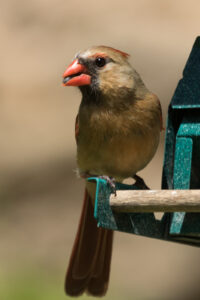
Behavior and Habitat:
- Territorial Tunes: Males fiercely defend their territories throughout the year, using their songs and displays to warn off rivals. These fights are more often vocal than physical, with puffed feathers and pointed beaks serving as a deterrent.
- Family First: Cardinals are monogamous breeders, forming strong pair bonds and cooperatively raising their young. They build sturdy nests in low shrubs and trees, where both parents care for the chicks.
- Adaptable Eaters: Their diet consists mainly of seeds, fruits, and insects. They readily visit feeders, enjoying sunflower seeds, berries, and suet cakes.
Conservation and Fun Facts:
- Population Powerhouse: Despite habitat loss and other challenges, Cardinal populations are generally stable and even expanding in some areas.
- State Bird Star: The Northern Cardinal is the official state bird of seven states, a testament to its widespread popularity and cultural significance.
- Yellow Surprise: In rare cases, a genetic mutation can result in yellow Cardinals, offering a delightful glimpse into avian diversity.
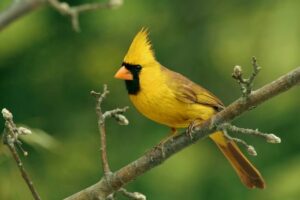
Frequently Asked Questions
What states do northern cardinals live in?
The Northern Cardinal is a widespread resident bird in North America, gracing the landscapes of many states and even venturing into southern Canada and Mexico. To answer your question more specifically, Northern Cardinals can be found in all 48 contiguous US states plus parts of southern Canada and northern Mexico.
Interestingly, the Northern Cardinal is the official state bird for a whopping seven states: Illinois, Indiana, Kentucky, North Carolina, Ohio, Virginia, and West Virginia. This widespread popularity and prevalence across such a diverse range of habitats speak volumes about the adaptability and charm of this iconic bird.
Here’s a breakdown of their general distribution:
- Eastern North America: Common throughout the eastern half of the United States and southern Canada, from Maine to Florida and west to Minnesota.
- Central and Western North America: Less common but present in parts of the Great Plains, Rocky Mountains, and Southwest, with populations reaching into Texas, New Mexico, Arizona, and southern California.
Remember, even within these broad regions, the specific distribution of Northern Cardinals can vary depending on habitat suitability, food availability, and other environmental factors. Local birding resources and field guides can help you pinpoint their presence in specific areas within your state or region.
Why are northern cardinals important?
Northern Cardinals play a vital role in the environment and our lives, contributing to the ecosystem in several important ways:
- Seed Dispersal: Their diet of various fruits and seeds ensures they spread them around their habitat as they forage. This aids in plant reproduction and contributes to forest regeneration.
- Insect Control: They consume a significant number of insects, including some that can be harmful to trees and crops. This natural pest control helps maintain ecological balance.
- Biodiversity Indicator: Their presence in an area is often seen as a sign of a healthy and diverse ecosystem, as they require a variety of resources and suitable habitat for survival.
What animal eats cardinals?
While Northern Cardinals are vibrant and feisty songbirds, they do face threats from various predators in their natural environment. Here’s a look at some of the animals that hunt and eat cardinals:
Birds of Prey:
- Hawks: Large hawks like Cooper’s Hawks, Sharp-shinned Hawks, and Red-tailed Hawks are agile predators with keen eyesight and powerful talons. They can swoop down and capture cardinals, especially during breeding season when adults may be distracted protecting their nests.
- Owls: Owls like Great Horned Owls and Eastern Screech Owls are silent hunters with excellent night vision. They can silently approach and capture cardinals, particularly at dusk or dawn.
Mammals:
- Domestic Cats: These feline companions pose a significant threat to cardinals, especially in backyards and residential areas. Their stealthy nature and hunting instincts make them adept at catching birds off guard.
- Squirrels: While primarily herbivores, squirrels can occasionally prey on young cardinals or eggs in unguarded nests.
- Foxes: These opportunistic omnivores may hunt cardinals, especially during harsh winter months when other food sources are scarce.
Snakes:
- Black Racers: These fast and agile snakes can climb trees and readily hunt down young cardinals or eggs in nests.
- Milk Snakes: Similar to black racers, milk snakes can prey on eggs and young birds on the ground or in low vegetation.






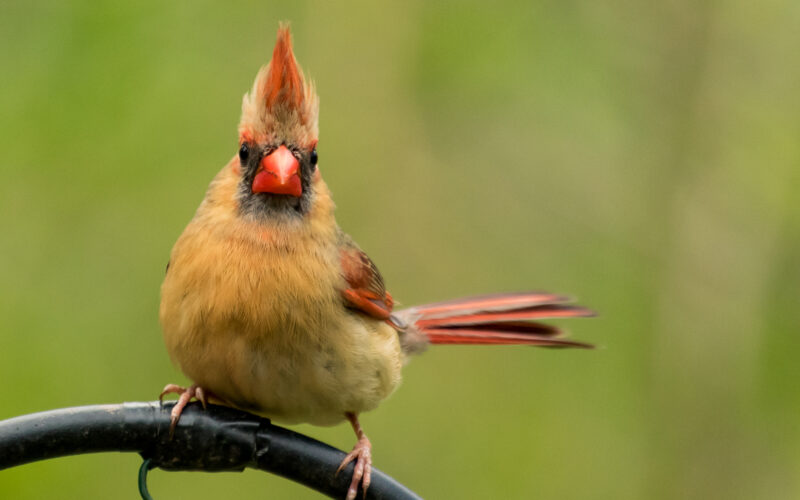
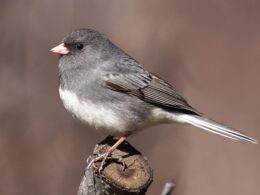
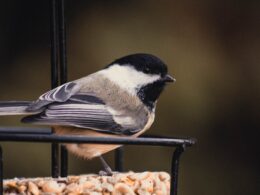
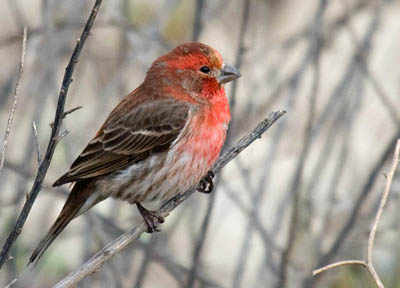
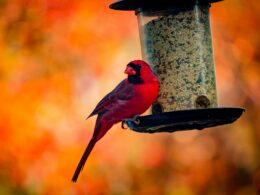
I have just discovered your posts. They are fascinating, so informative, and very helpful. Thank you so much from Western Pennsylvania.
You are welcome!